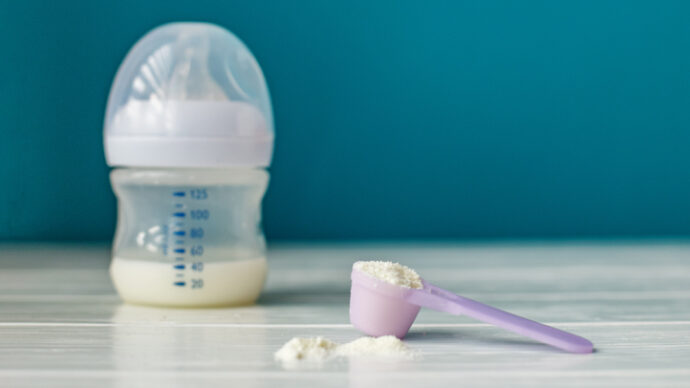The journey of feeding your baby is filled with decisions, and one of the most significant choices many parents face is when, or if, to introduce formula to a breastfed baby. The decision to introduce formulas can stem from various reasons. Whatever your reasons, it’s essential to ensure the transition is smooth for both you and your baby. This blog post aims to guide you through the process, offering tips and insights to ensure your little one’s nutritional needs are met with love and care.
Reasons for Introducing Formula
Every family’s feeding journey is unique. Some of the common reasons parents opt to introduce formula alongside breastfeeding include:
- The need to return to work or school
- Concerns about breast milk supply
- Medical reasons, either for the baby or the breastfeeding parent
- Personal choice or comfort
Regardless of your reasons, it’s crucial to remember that every family must choose what works best for them. There’s no one-size-fits-all approach, and it’s okay to tailor your feeding method to your family’s needs and circumstances.
Consulting a Pediatrician

Source: babycenter.com
Before making any decisions about introducing formulas such as The Milky Box, it’s essential to consult with a pediatrician. A healthcare professional can assess your baby’s unique needs, provide tailored advice, and answer any questions or concerns you might have. They can guide you on suitable formulas, amounts, and schedules, ensuring your baby receives the optimal nutrients.
Choosing the Right Formula
The market offers various infant formulas. The primary types include:
- Cow’s Milk-based Formula: Suitable for most babies, they contain all essential nutrients.
- Soy-based Formula: Ideal for babies allergic to cow’s milk or for vegetarian families.
- Hypoallergenic Formula: Designed for babies with allergies or intolerances.
To select the right formula:
- Consider any known allergies or intolerances.
- Check for formulas fortified with iron, as it’s crucial for infants.
- Opt for a brand with a good reputation and necessary certifications.
Gradual Introduction
Instead of an abrupt shift, a gradual introduction of formula can help your baby adjust to the new taste and composition. Start by replacing one breastfeeding session with a formula feed, then slowly increase the number of formula feeds as your baby becomes more accustomed. A typical timeline might look like introducing one formula feed every 2-3 days.
Mixing Breast Milk and Formula

Source: whattoexpect.com
Combining breast milk and formula can serve as an effective way to ease your baby into the new taste and consistency of the formula. Here’s a simple way to achieve this blend:
- First, prepare the formula according to the brand-specific instructions.
- Next, add the desired amount of freshly expressed breast milk to the formula.
- Crucially, ensure that both the breast milk and formula are at similar temperatures to prevent curdling or changes in texture.
- It’s always a good practice to shake the mixture gently to ensure a smooth blend.
Remember, while many parents find success in this method, it’s essential to consult your pediatrician about appropriate ratios and mixing techniques to ensure optimal nutrition and digestion for your baby.
Nipple Selection
The bottle nipple can play a surprisingly large role in a baby’s acceptance of bottle-feeding. Here are factors to weigh:
- Flow Rate: Especially for newborns, a slow-flow nipple can mimic the natural flow of breast milk, making the transition easier.
- Shape: The shape can make a difference. While some babies take easily to orthodontic nipples, others might lean towards a more natural nipple shape that resembles a mother’s breast.
- Material: Nipple materials vary. Silicone nipples are durable and less likely to retain odors, while latex, though softer, may wear out faster and isn’t suitable for babies with latex allergies.
It might require a few trials to find out which nipple your baby is most comfortable with. It’s all about observing their reaction and preferences.
Feeding Positions
Positioning is more than just comfort; it’s about ensuring effective feeding and bonding. Two popular positions include:
Cradle Hold: Here, you’ll be holding your baby’s head gently in the crook of your arm, reminiscent of the breastfeeding position. This closeness can comfort a baby used to breastfeeding.
Football Hold: This involves tucking your baby under your arm, their body extending to your back, almost like holding a football. This position often gives a clearer view of the baby’s face, letting you observe their reactions during feeding.
Consider using specially designed nursing pillows or even regular cushions to provide additional support, making feeding more comfortable for both you and your baby.
Expressing and Storing Breast Milk

Source: abm.me.uk
When you’re mixing breast milk with formula, the quality of the expressed milk matters. Follow these steps:
- Ensure you wash your hands thoroughly before expressing to keep any contaminants away.
- Use a sterilized container to collect the milk, ensuring its safety and purity.
- If not using the expressed milk immediately, refrigerate it without delay. For reference, breast milk can stay fresh in the back of a refrigerator for up to four days. If you’re planning longer storage, freeze it, where it can be kept for up to six months.
Knowing these guidelines helps maintain the quality and nutritional value of the milk.
Recognizing Hunger Cues
Your baby communicates their hunger in several subtle ways:
- They might start sucking on their fingers or hands, signaling an early hunger cue.
- Rooting is another sign, where they turn their head towards anything that strokes or touches their cheek, essentially looking for a nipple.
- Observe for mouthing motions or increased salivation.
Catching these cues early and responding promptly ensures that your baby doesn’t reach a point of intense hunger, making feeding smoother and more effective.
Maintaining Bonding

Source: unplannedpregnancy.com
Bonding transcends the method of feeding. Even while bottle-feeding formula, there are ways to ensure that emotional connection remains strong:
- Prioritize maintaining eye contact. It forms a deep emotional connection and reassures your baby.
- Hold your baby close, allowing them to feel your warmth and heartbeat.
- Talk softly or sing during feeds. Your voice is a comforting and familiar sound to them.
- Try skin-to-skin contact. This tactile connection promotes emotional security and has been shown to offer numerous developmental benefits for the baby.
Troubleshooting Common Issues
Transitioning can present challenges, such as nipple confusion or formula rejection. If your baby resists the bottle, experiment with different nipples or feeding environments. Always consult your pediatrician if concerns persist.
Introducing formula to a breastfed baby is a personal decision. With preparation, patience, and love, you can ensure that this transition is as smooth as possible for both you and your baby.




